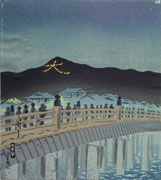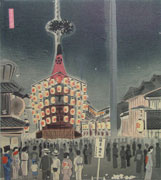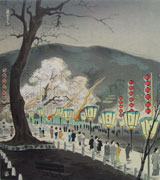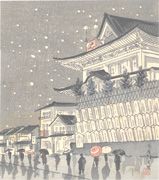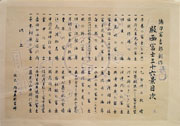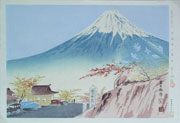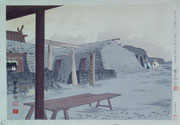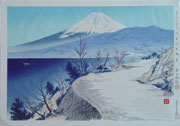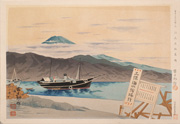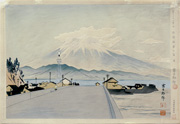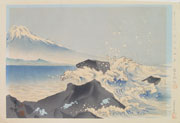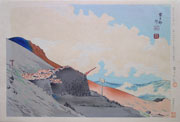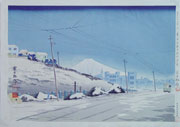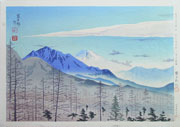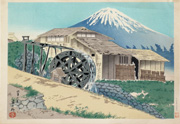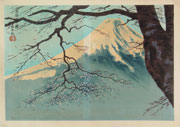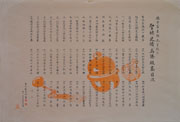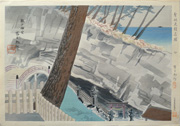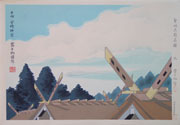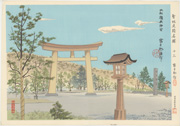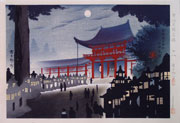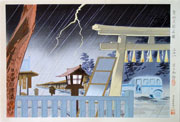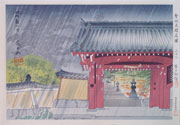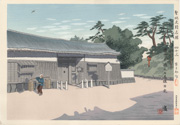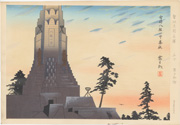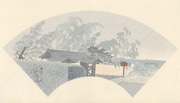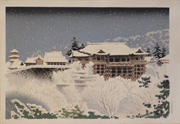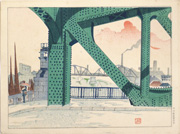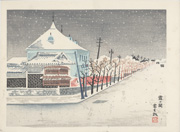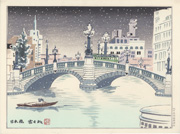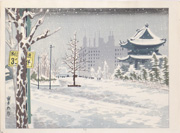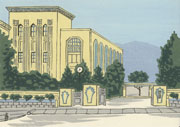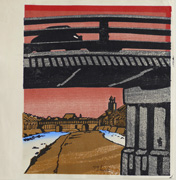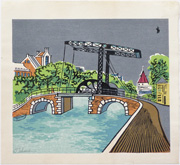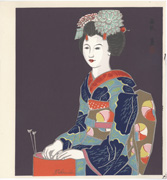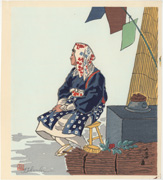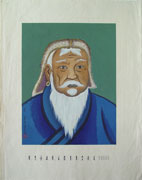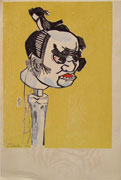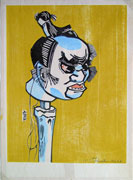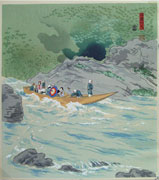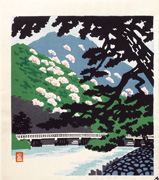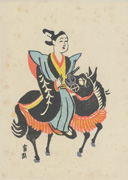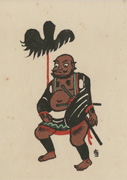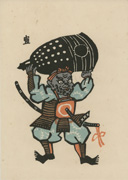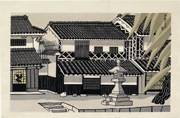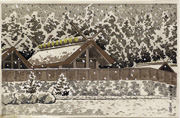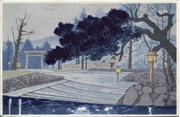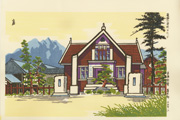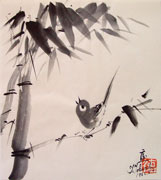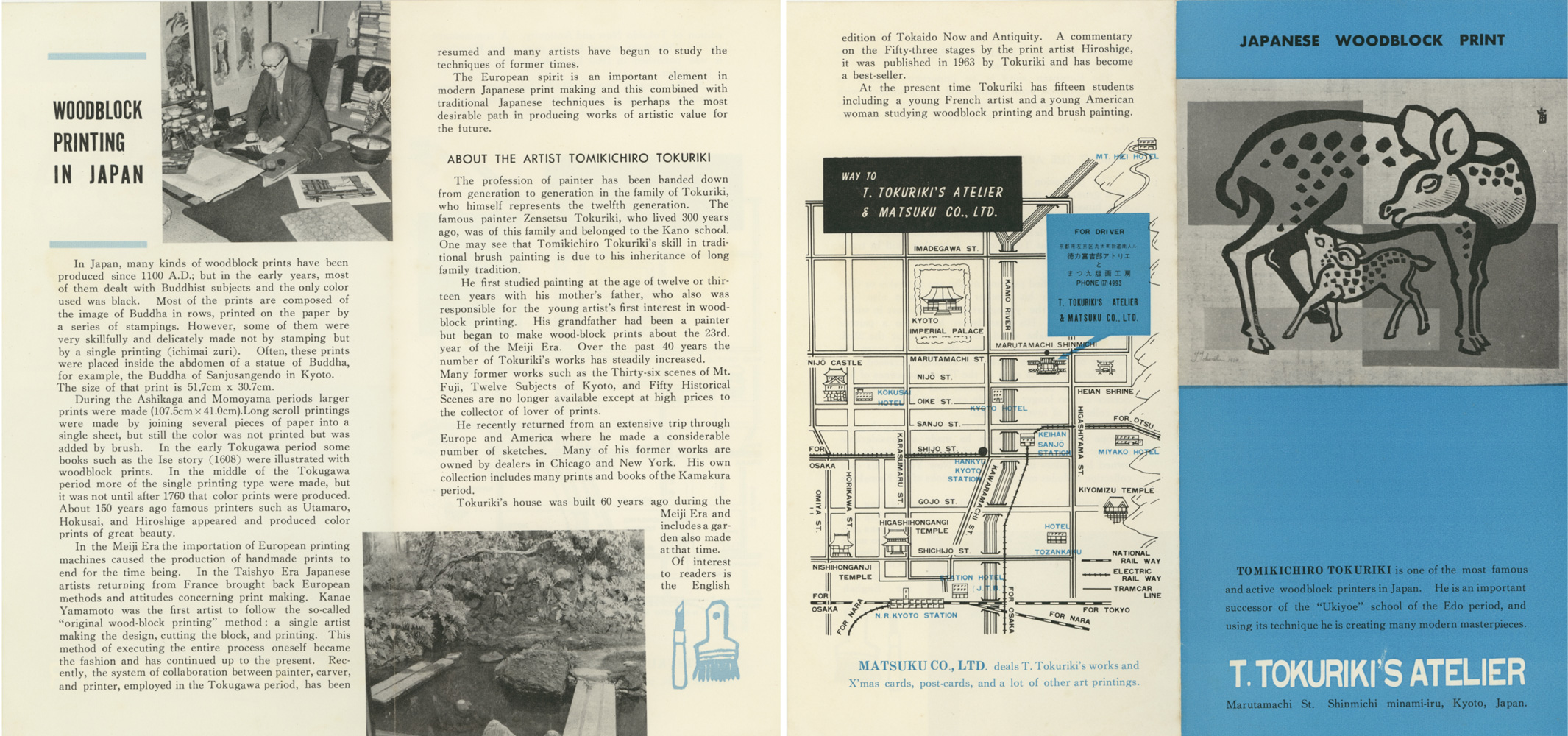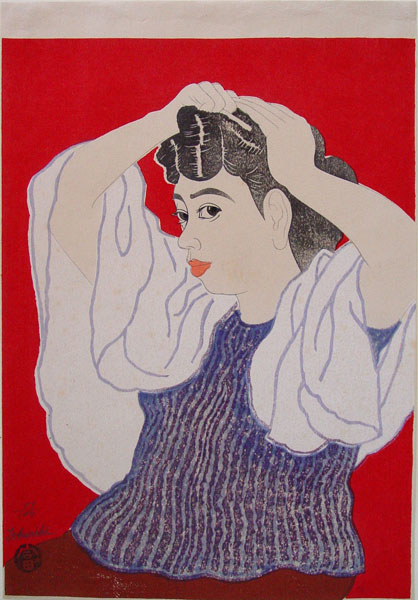Prints in Collection
Minami-za Kaomise, c. 1936
IHL Cat. #2416
| Clear Weather after Snow at Ochanomizu, Tokyo #31 from the series Thirty-six Views of Mount Fuji, 1939-1940 IHL Cat. #415 | Distant View of Fuji from Shinshu Kiyosato Station #34 from the series Thirty-six Views of Mount Fuji, 1939-1940 IHL Cat. #411 | -intentionally left blank- |
Watermill, c. late 1940s IHL Cat. #566 | The Cherry Blossoms of Tateho from the series The Eight Views of Mt. Fuji, c. 1950s IHL Cat. #413 | Fall Harvest from the series The Eight Views of Fuji, c. 1950s IHL Cat. #412 |
IHL Cat. #1102 | IHL Cat. #1650 |
IHL Cat. #1307 | 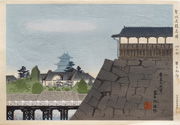 Hiroshima Daihonei #47 from the series Scenes of Sacred and Historic Places, 1941 IHL Cat. #1101 |
| Hakkō Ichiu Tower in Miyazaki #50 from the series Scenes of Sacred and Historic Places, 1941 IHL Cat. #1663 | -intentionally left blank- | -intentionally left blank- |
Tsuten-kyo Autumn Leaves from the series Kyoto in Autumn, 1942 IHL Cat. #2419 | Kōdaiji Temple, Hagi from the series Kyoto in Autumn, 1942 IHL Cat. #2420 | -intentionally left blank- |
Sumida River from the series Eight Views of Tokyo, 1942 IHL Cat. #620 | IHL Cat. #1093 | from the series Eight Views of Tokyo, 1942 IHL Cat. #1094 |
IHL Cat. #621 | 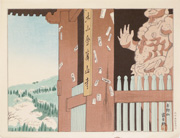 Yoshinoyama from the series Eight Scenic Views of Yamato Road, c. 1950s IHL Cat. #644 | Building, undated IHL Cat. #491 |
| | |
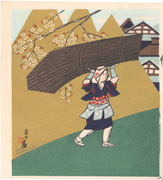 IHL Cat.#1212 | Oharame (seated), c. 1960s IHL Cat. #1213 |
| Woman Combing Her Hair, 1947 IHL Cat. #98 | IHL Cat. #1804 |
Chinggis Khan,
c. 1950s-1960s
IHL Cat. #149
A Bunraku Puppet Head,
1962
IHL Cat. #275
1962
IHL Cat. #314
 The Fireflies of Uji River, The Fireflies of Uji River,c. 1950s IHL Cat. #382 | The Hozu-gawa Rapids at Kyoto in Summer, c. 1950s IHL Cat. #150 | Arashiyama in Spring, c. 1950s IHL Cat. #1074 |
| Otsu-e: Wisteria Maiden, c. 1955 IHL Cat. #677 | Otsu-e:Standard Bearer, c. 1955 IHL Cat. #678 | Otsu-e: Benkei and the Bell, c. 1955 IHL Cat. #679 |
| Private House in Kurashiki, c. 1960s IHL Cat. #772 | Ise Shrine, c. 1970s IHL Cat. #831 | Gardens of the Inner Ise Shrine, c. 1970s IHL Cat. #830 |
Old Elementary School Building in Komono, 1973
IHL Cat. #1915
Profile
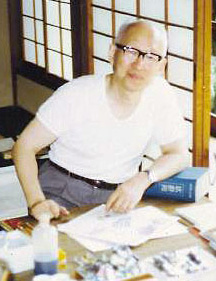 Tokuriki Tomikichiro c. 1974 (Photo by Lynn Shimizu) | Tokuriki Tomikichirō 徳力富吉郎 (1902-2000) The art of Tomikichirō Tokuriki is an important bridge between the two great movements of Japanese art in the early twentieth century; shin hanga and sosaku hanga. Like the classic shin hanga masters of the day, Tokuriki designed many woodcuts of landscapes and city views in the traditional manner. Yet he actively promoted sosaku-hanga (creative prints) in Kyoto, which emphasized the artist’s participation in the entire process of printmaking and the exploration of more modern styles and trends. After WWII Tokuriki set up his own publishing company called Matsukyū and began to teach block-carving to artisans and artists, many of them foreigners. He also wrote extensively on the technique of woodblock carving and printing. He traveled extensively throughout the United States and Europe and in the 1960’s he opened several exhibitions of his works in major U.S. cities such as, New York, Chicago, Cleveland and Pittsburgh. |
I'd rather do nothing but creative prints, but after all, I sell maybe ten of them against two hundred for a publisher-artisan print. - Tokuriki
Biography
Sources: Website of the International Fine Print Dealers Association (IFPDA) http://www.printdealers.com/content/node/2219; British Museum website http://www.britishmuseum.org/research/search_the_collection_database/term_details.aspx; Guide to Modern Japanese Woodblock Prints: 1900-1975, Helen Merritt, University of Hawaii Press, 1992, p. 153.
Tokuriki Tomikichirō was born in 1902 into a family of Kyoto artists that can be traced back as far as 1596. His first teacher was his grandfather and he credits him with sparking his interest in prints. "During his lifetime he made seventy-two flower prints," says Tokuriki. "When I was a child I loved to look at them, and they were my introduction to hanga."1
He entered the Kyoto School of Arts and Crafts and completed a two-year preparatory class and four years of regular training. He then attended the Kyoto City Specialist School of Painting in 1924 for a three year course of study. In 1928 he studied Nihonga (Japanese style) painting under Tsuchida Bakusen (1887-1936) and Yamamoto Shunkyo (1871-1933) and he exhibited with Kokuga Sosaku Kyokai (National Painting Creative Association.) In 1929 he abandoned painting for woodblock printing under the influence of Hiratsuka Un'ichi (1895-1997) and began to contribute to the early print magazine Han.
"It was only a little after I'd seriously turned to prints that Hiratsuka came to Kyoto to teach a short course, spreading the doctrine of creative prints. Since I had some training I assisted him and in that way received an introduction to the Tokyo artists. I joined the Hanga Association and actively participated in a magazine called Han put out by a group close to Hiratsuka, men like Masao Maeda (1904-1974), Kihachiro Shimozawa (1901-1984), Hide Kawanishi (1894-1965), and Shiko Munakata (1903-1975). It was a good magazine, but like all the rest, short-lived."2 Tokuriki also contributed to the print magazines Shin hanga and Kitsusuki and organized the Red Green Society (Tanryokukai) which put out Collection of Small Prints (Han shohinshu).
In addition to training with Hiratsuka, Tokuriki also studied printmaking with the engraver (carver) Keikichi Hono and the printer Tokuzo O'iwa [who reportedly was a printer for Utagawa Hiroshige III (1842–1894).]
Tokuriki was a leading artist and promoter of sosaku hanga in Kyoto. He exhibited with Kokugakai (National Picture Association), Nihon Hanga Kyokai (Japan Print Association), Shun'yokai (Spring Principle Association), and the various iterations of state-controlled exhibitions, i.e. Teiten, Shin Bunten, Nitten, and in numerous solo exhibitions in Japan and abroad. He was a member of Nihon Hanga Kyokai (Japan Print Association) from 1932 and was a co-founder of the Kyoto magazine Taishu hanga in 1932, which helped create the sense of a Kyoto school of the sosaku hanga movement.
He produced many sets of prints before and during World War II based on traditional subjects, such as Shin Kyoto fukei (New Views of Kyoto, 1933-4), which also included designs by Asada Benji (1899-1984) and Asano Takeji (1900-1999), Tokyo hakkei (Eight Views of Tokyo, 1942), Thirty-Six Views of Mt. Fuji and Thirty Views of Kyoto, the last two of which sold a thousand copies.3 Most of his traditional prints (shin hanga style) were printed and published by three Kyoto publishing houses: Uchida Wood Block Printing Company (Uchida Publishing), Unsodo Publishing and Kyoto Hanga-in, but after the war Tokuriki set up his own publishing company called Matsukyū4 [末詳 (まつ九)] Publishing Company to print and publish his prints. In addition to print publishing, Matsukyū also taught block-carving to artisans and artists. In 1948 Tokuriki set up a sub-company of Matsukyū called Kōryokusha5 with fellow artists Kotozuka Eiichi (1906-1979), Kamei Tōbei (1901-1977) and Tasaburo Takahashi (1904-1977) to publish and exhibit their creative prints (sosaku hanga).
click on image to enlarge
Matsuko Company (Matsukyū) brochure "T. Tokuriki's Atelier", c. 1964
Tokuriki was a prolific print artist throughout his life, creating over 10,000 works6, and was active in writing about print making and teaching until he was into his 90s. In addition to Japanese artists he also taught printmaking to a number of foreign artists including David Stones and Daniel Kelly. In 1968 he wrote the small book Wood-block Printing in the preface of which he states "I have tried to write this book for those who wish to learn the exquisite technique of Japanese wood-block printing... If you have any further questions please visit me at my atelier or write to me." His door seemed to be always open.
Daniel Kelly, a student of Tokuriki's, tell us that Tokuriki taught him some important lessons about issues other than technique. "Tokuriki said that, during the Edo period, a woodblock print was the same price as a bowl of noodles. He advised me not to be expensive, not to be elitist. He said it's for the public because it's printed art. Make it accessible to the world."7
Tokuriki traveled extensively throughout the United States and Europe and in the 1960’s he opened several exhibitions of his works in major U.S. cities such as, New York, Chicago, Cleveland and Pittsburgh.
Kyoto and The Artist's Style
The collector and author, Oliver Statler, in discussing the differences between Tokyo-based and Kyoto-based woodblock print artists writes8:
| In discussing Kyoto prints, Dr. Fujikake has said that they suggest painting rather than woodblock, and Tokuriki agrees with him. "I know that we adhere very closely to the brush stroke," he says. "Perhaps Kyoto print artists are too accomplished technically. We were never gripped by the same rebellion against ukiyoe technique that motivated the Tokyo artists, and while not all of the men here sought out artisans for training as I did, they have all worked to acquire the same discipline, and they're proud of it; they like to point this up by saying: 'Tokyo artists can't get a hundred copies from their blocks." If one asks why the Kyoto artists cling to an artisan approach, Tokuriki answers that the hanga artists of Tokyo developed from Western-style painters trained in oil, while the Kyoto artists are men whose background is Japanese painting and in sumi and water color. There is little friendship between oil and the chisel, but Japanese painting gets on very well with the carving tools. Thus the artist who turn to woodblock from oil is in revolt and seeking a new mode of expression, but the artist who moves to prints from Japanese painting makes a smooth transition to a medium compatible with the style he was trained to; if he wants break away from mere reproduction of that line and stroke, he has to fight to do it. Tokuriki's artisan prints reveal how closely the woodblock can be made to conform to the water color, but the best of his creative prints, like Woman Combing Her Hair and Sanjo Bridge, show a resolute effort to design with the knife. "I want to break away from the brush," says Tokuriki. |
George Kuwayama in his comments for the catalog of the Los Angeles County Museum of Art's 1972 exhibition Contemporary Japanese Prints finds that Tokuriki "despite his traditionalism, is a modern print master. His palette is Fauvist (i.e., vivid) and the strong, expressive lines are gouged with a knife to produce jagged contours."9
Series - Partial List
Eight Views of Tokyo (Tokyo hakkei), 1942
Views of Tokyo in the Four Seasons (Shiki Tokyo Fukei), c. 1940s, printed by Uchida
Thirty Scenes of Kyoto (Kyoraku Sanjudai), 1939, published by Uchida
New View of Kyoto (Shin Kyoto Fukei), 1933-34
Thirty-Six Views of Mt. Fuji (Honen no Fuji), c. 1939-40, published by Uchida, 36 print set
The Eight Views of Mt. Fuji, c. 1950s, published by Uchida, 8 print set (each print originally issued as part of the series Thirty-Six Views of Mt. Fuji.
Twelve Views of Kyoto, published by artist
Noted Place of Kyoto, published by artist
Selections from Prints of Places of Historic and Scenic Interest, 1941, published by Uchida
Four Seasons of Kyoto (Shiki Kyoto fukei), published by the artist's publishing company Matsukyū
Scenes of Sacred Places and Historic Landmarks (Seichi Shiseki Meisho), 1941, published by Uchida, 50 print set
One Hundred Print Scenes of Kyoto (Hanga Kyoto hyakkei), 1975.
Fifteen Views of Kyoto, published by Uchida
The Album of Famous Views in Japan, c. 1950s, published by Uchida, 6 print set (each print originally issued as part of the series Scenes of Sacred Places and Historic Landmarks.
Twelve Months of Kyoto (Kyô-meishô jûnikagetsu), 1945, published by Uchida
Collection of Eight Famous Places in Kyoto (Kyo Meisho Hasshu), published by Uchida
Twenty views of Kyoto (Hanga kyoraku niju-kei), c. 1945, published by Uchida
New Eight Views of Omi, published by Uchida.
New Thirty-six Views of Mt.Fuji (Shin Fuji Sanju-Rokkei: Koshu Kaido), self-published
The Ten Views of Japan, published by Uchida
Note that many of Tokuriki's prints published by Uchida were re-printed through the years, sometimes as parts of re-named series. (See below for more information on this.) The above dates, where given, reflect the date of original publication as provided by various sources, although the existing information is incomplete and sometimes conflicting.
The Series - Thirty-six Views of Mt. Fuji and Scenes of Sacred Places and Historic Landmarks
These two very popular series are examples of series originally published by Uchida Bijutsu Shoten in the late 1930s and early 1940s from which individual prints were re-published by Uchida in later years, either as individual prints or as a part of a newly titled series. Eight prints from Thirty-Six Views of Mt. Fuji, originally published between 1939 and 1940, were re-issued sometime in the 1950s as part of the series The Eight Views Of Mt. Fuji and six prints from Scenes of Sacred Places and Historic Landmarks, originally published in 1941, were republished in the 1950s as The Album of Famous Views of Japan.
The table below shows the eight prints in the series The Eight Views of Mt. Fuji and the corresponding prints as originally issued as part of the series Thirty-six Views of Mt. Fuji. In most cases the original print titles were shortened for the newer series and the text in the right margin of the original issue was eliminated. It is difficult to tell from the photographic images if the blocks were modified or re-carved for some prints but, as can be seen in the second print below, the third telephone pole on the right of the green hill present in the Thirty-six Views of Mt. Fuji print is not present on the print included in The Eight Views of Mt. Fuji. Due to color changes introduced by photography and the toning of some of the below prints, it's impossible to tell if any color scheme changes were introduced in the prints for the later series, but I suspect there were.
The English titles of the individual prints in the series The Eight Views of Mt. Fuji are taken from University of Chicago's Smart Museum of Art On-Line Database which, I assume, copied them from the original folio. The English titles for the prints in Thirty-six Views of Mt. Fuji are derived from multiple sources on the web.
Print Comparison Between Eight-Views and Thirty-six Views of Mt. Fuji
| The Eight Views of Mt. Fuji c. 1950s | Thirty-six Views of Mt. Fuji 1939-1940 |
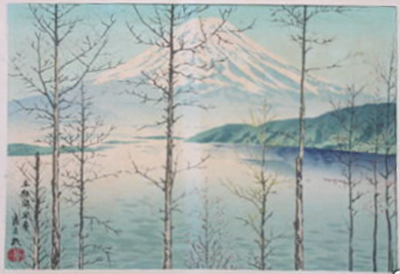 Lake Motosu in Early Spring | 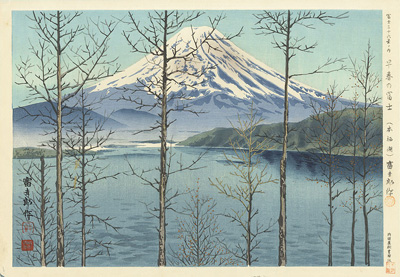 Fuji in Early Spring (Lake Motosu) |
 The Harvest Tide |  |
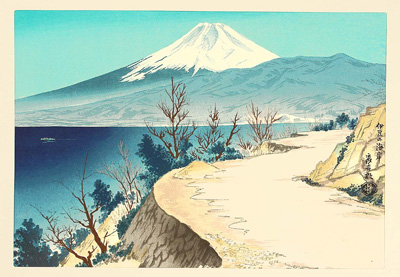 | 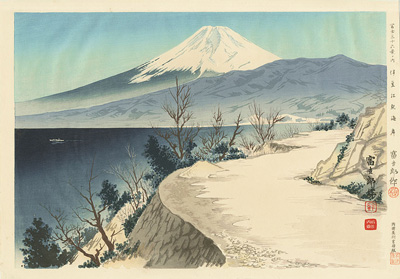 |
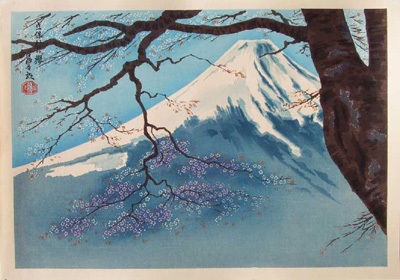 The Cherry Blossoms of Tateho | 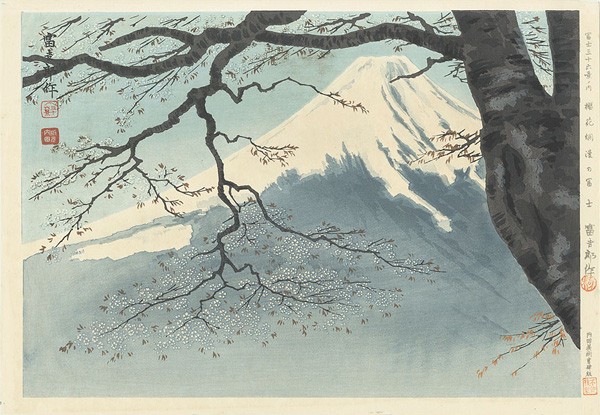 |
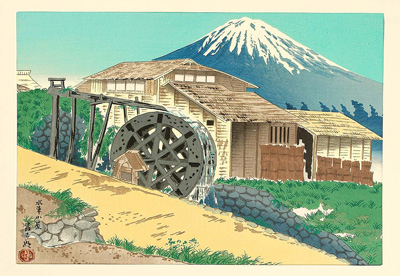 The Water-Mill | 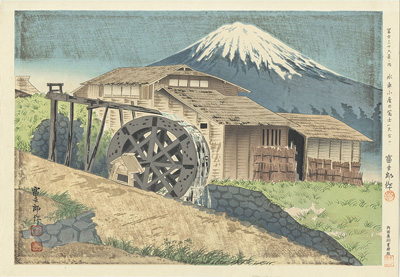 |
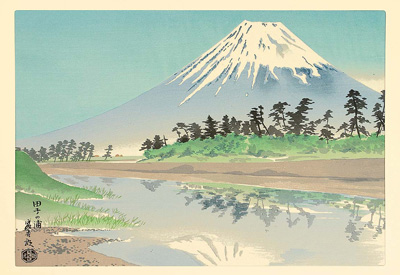 The Tagonoura Bay | 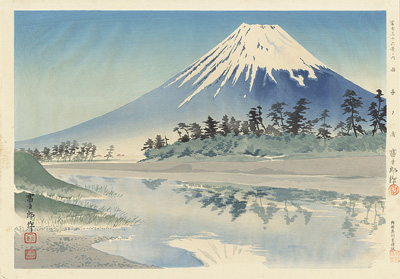 |
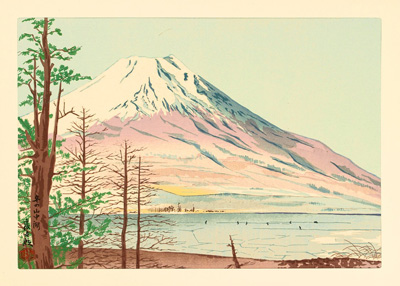 The Lake Yamanaka in Winter Fuyu no Yamanaka-ko | 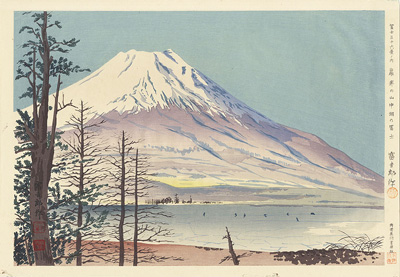 |
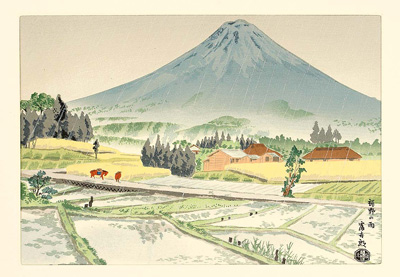 The Rain in Susono (Susono no Ame) | 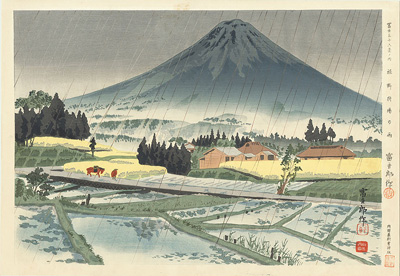 Rain at Susono (at the base of Mt. Fuji) Rain at Susono (at the base of Mt. Fuji) |
Table of Print Titles
| Lake Motosu in Early Spring ------------------- Fuji in Early Spring (Lake Motosu) | The Harvest Tide ------------------- Fuji from Honen | The Skirts of Mt. Fuji ------------------- Izu Eri Coast | The Cherry Blossoms of Tateho ------------------- Cherry Blossoms of Tateho near Mt Fuji |
8 Views | 36 Views  | 8Views | 36 Views | 8 Views | 36 Views | 8 Views | 36Views |
| The Water-Mill ------------------- Fuji from the Watermill at the Mouth of Omiya | The Tagonoura Bay ------------------- Tago Bay | The Lake Yamanaka in Winter ------------------- Fuji from Lake Yamanaka | The Rain in Susono ------------------- Rain at Susono (at the base of Mt. Fuji) |
8Views  | 36Views | 8Views | 36Views | 8 Views | 36Views | 8 Views | 36Views |
Various Seals and Signatures
 |  |  | 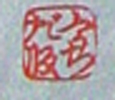 Uchida "U Chi Da Han" publisher's seal often misidentified as the artist's seal |  | 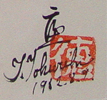 "toku" or "tomi" seal |
 Tomikichiro saku (made by Tomikichiro) |  Tomikichiro saku (made by Tomikichiro |  Tomikichiro with Tokuriki 徳力seal |  Tomikichiro kin saku with Tokuriki 徳力seal |  Tomikichiro |  |
 富 "tomi" seal |  富吉郎 富吉郎tomikichiro | 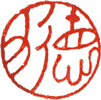 徳力 Tokuriki | 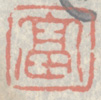 富 富"tomi" seal |
Collections - Partial List
Museum of Fine Arts, Boston; University of Alberta Art Collection; Aichi Prefectural Museum of Art, Nagoya; Art Gallery of Greater Victoria; Carnegie Museum of Art; Five College Museums/Historic Deerfield Collections; Harvard Art Museum; Los Angeles County Museum of Art; The National Museum of Modern Art, Tokyo; Fine Arts Museums of San Francisco; The David and Alfred Smart Museum of Art, University of Chicago; Weatherspoon Art Museum, Greensboro; Brooklyn Museum; Yale University Art Gallery
1 Modern Japanese Prints: An Art Reborn, Oliver Statler, Charles E. Tuttle Company, 1956, p. 119.
2 Ibid, p. 120.
3 University of Alberta Collections website http://museums.ualberta.ca/art/details.aspx?key=16055&r=0&t=1
4 also seen written as Matsuku
5 also seen written as Korōkusha and Koroku-Sya)
6 this number comes from the website of Matsukyū, the continuation of Tokuriki's publishing company which functions, in part, as a museum today under the name 株式会社 京都徳力版画館 (Kabushikigaisha Kyōto Tokuriki hangakan) http://www.kyoto-matsukyu.jp/data/hanga.html7 Verne Collection website http://www.vernegallery.com/daniel-kelly/
8 Statler, p. 121-122.
9 Contemporary Japanese Prints, George Kuwayama, Los Angeles County Museum of Art, 1972, p. 36.
last revision:
12/31/2020
![Index for the series Thirty Subjects [Views] of Kyoto](tokuriki-tomikichiro-1902-1999/Table of contents 30 views of-4ef43781ce2e2ede.jpg)
